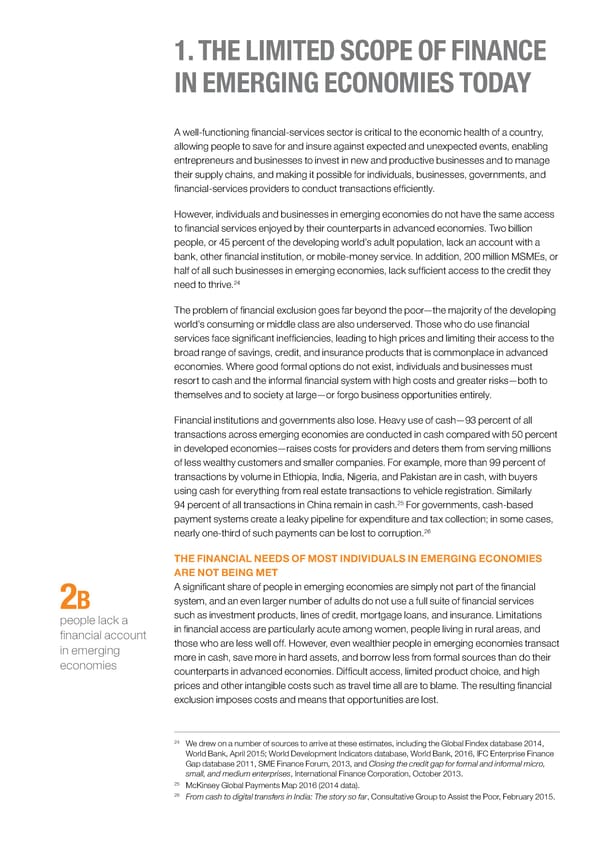1. THE LIMITED SCOPE OF FINANCE IN EMERGING ECONOMIES TODAY A well-functioning financial-services sector is critical to the economic health of a country, allowing people to save for and insure against expected and unexpected events, enabling entrepreneurs and businesses to invest in new and productive businesses and to manage their supply chains, and making it possible for individuals, businesses, governments, and financial-services providers to conduct transactions efficiently. However, individuals and businesses in emerging economies do not have the same access to financial services enjoyed by their counterparts in advanced economies. Two billion people, or 45 percent of the developing world’s adult population, lack an account with a bank, other financial institution, or mobile-money service. In addition, 200 million MSMEs, or half of all such businesses in emerging economies, lack sufficient access to the credit they need to thrive.24 The problem of financial exclusion goes far beyond the poor—the majority of the developing world’s consuming or middle class are also underserved. Those who do use financial services face significant inefficiencies, leading to high prices and limiting their access to the broad range of savings, credit, and insurance products that is commonplace in advanced economies. Where good formal options do not exist, individuals and businesses must resort to cash and the informal financial system with high costs and greater risks—both to themselves and to society at large—or forgo business opportunities entirely. Financial institutions and governments also lose. Heavy use of cash—93 percent of all transactions across emerging economies are conducted in cash compared with 50 percent in developed economies—raises costs for providers and deters them from serving millions of less wealthy customers and smaller companies. For example, more than 99 percent of transactions by volume in Ethiopia, India, Nigeria, and Pakistan are in cash, with buyers using cash for everything from real estate transactions to vehicle registration. Similarly 94 percent of all transactions in China remain in cash.25 For governments, cash-based payment systems create a leaky pipeline for expenditure and tax collection; in some cases, 26 nearly one-third of such payments can be lost to corruption. THE FINANCIAL NEEDS OF MOST INDIVIDUALS IN EMERGING ECONOMIES ARE NOT BEING MET A significant share of people in emerging economies are simply not part of the financial 2B system, and an even larger number of adults do not use a full suite of financial services people lack a such as investment products, lines of credit, mortgage loans, and insurance. Limitations financial account in financial access are particularly acute among women, people living in rural areas, and in emerging those who are less well off. However, even wealthier people in emerging economies transact economies more in cash, save more in hard assets, and borrow less from formal sources than do their counterparts in advanced economies. Difficult access, limited product choice, and high prices and other intangible costs such as travel time all are to blame. The resulting financial exclusion imposes costs and means that opportunities are lost. 24 We drew on a number of sources to arrive at these estimates, including the Global Findex database 2014, World Bank, April 2015; World Development Indicators database, World Bank, 2016, IFC Enterprise Finance Gap database 2011, SME Finance Forum, 2013, and Closing the credit gap for formal and informal micro, small, and medium enterprises, International Finance Corporation, October 2013. 25 McKinsey Global Payments Map 2016 (2014 data). 26 From cash to digital transfers in India: The story so far, Consultative Group to Assist the Poor, February 2015.
 DIGITAL FINANCE FOR ALL Page 28 Page 30
DIGITAL FINANCE FOR ALL Page 28 Page 30